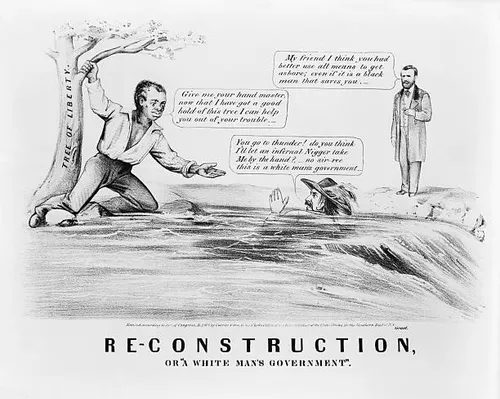The misnaming of Moors as blacks during the Reconstruction era is a historical oversight that has had profound implications on the narratives of identity and representation. This article delves into the complex interplay between historical misnaming, erasure of Moorish contributions, and the evolution of labels such as black, colored, and BIPOC. By exploring the impact of misnaming on identity and the challenges of reclaiming Moorish history, we aim to shed light on a significant aspect of history that has been marginalized and overlooked. Join us on a journey to uncover the truth about Reconstruction and the pivotal role Moors played in shaping our collective heritage.
1. Introduction to the Misnaming of Moors as Blacks
The Significance of Historical Misnaming
There’s a curious case of mistaken identity in history, where Moors were mislabeled as blacks, leading to a tangled web of confusion. This misnaming not only erased the rich history of Moors but also distorted our understanding of the Reconstruction era and its impact on marginalized communities.
2. The Historical Context of Moors During Reconstruction
Moors in the Reconstruction Era
During the Reconstruction era, Moors played a significant role in shaping the cultural and social landscape. However, their contributions were overshadowed by the prevailing prejudices and misinterpretations of the time.
Shifts in Identity and Terminology
As the Reconstruction era unfolded, there were shifts in how Moors identified themselves and how others perceived them. The evolving terminology reflected the complexities of race, ethnicity, and power dynamics during this tumultuous period.
3. Erasure of Moors from Historical Narratives
Revisionist History and Omissions
Sadly, the historical narrative has often omitted or downplayed the presence and influence of Moors, contributing to a distorted view of Reconstruction and its participants. This erasure has had far-reaching implications for our understanding of the past.
Impact on Understanding of Reconstruction
By excluding Moors from the narrative, we miss out on crucial insights into the diverse experiences and perspectives that shaped Reconstruction. This oversight not only does a disservice to their legacy but also hinders our ability to grasp the full complexity of this crucial period in American history.
4. The Evolution of Labels: From Moors to Black, Colored, and BIPOC
Changing Terminology and Connotations
Over time, the labels used to describe marginalized communities have shifted, reflecting changing societal norms and attitudes. The journey from Moors to black, colored, and now BIPOC highlights the fluidity of identity and the power dynamics embedded within these terms.
Implications for Identity and Community
The evolution of labels has profound implications for how individuals perceive themselves and how communities organize around shared identities. Understanding this evolution is key to navigating the complexities of race, ethnicity, and belonging in today’s diverse society.
5. Impact of Misnaming on Identity and Representation
Psychological and Societal Effects
Being misnamed as “black,” “colored,” or “BIPOC” has profound psychological impacts on individuals who identify as Moors. It erases their unique historical and cultural identity, leading to feelings of disconnect and erasure. Societally, misnaming perpetuates the erasure of Moorish contributions to history, reinforcing the marginalization of this community.
Misconceptions and Stereotyping
Misnaming Moors as other identities perpetuates misconceptions and stereotypes. It contributes to a lack of understanding and appreciation for Moorish culture and history, leading to biased beliefs and limited representation in mainstream narratives. Dispelling these misconceptions is crucial for fostering inclusivity and diversity in historical discourse.
6. Reclaiming the History and Identity of Moors
Challenges in Historical Reconstruction
Reclaiming the history and identity of Moors presents various challenges, including untangling centuries of misnaming and erasure. It requires a concerted effort to uncover hidden narratives and elevate the voices of Moors in historical accounts, confronting the biases that have shaped mainstream understanding.
Empowering Moors in Modern Discourse
Empowering Moors in modern discourse involves amplifying their perspectives, reclaiming their history, and challenging existing narratives that have marginalized them. By centering Moorish voices and experiences, we can create a more inclusive and accurate portrayal of history that reflects the diversity and richness of our collective past.
7. Recognizing the Contributions of Moors to Reconstruction
Restoring Historical Narratives
Recognizing the contributions of Moors to reconstruction requires a reevaluation of historical narratives to include their vital roles and achievements. By acknowledging the impact Moors had on shaping history, we can create a more comprehensive and accurate representation of the past that honors their legacies.
Highlighting Moors’ Achievements and Legacies
Highlighting the achievements and legacies of Moors is essential for acknowledging their significant contributions to various aspects of society. From art and science to governance and commerce, Moors have left indelible marks on history that deserve recognition and celebration, enriching our understanding of the world.
8. Moving Towards an Inclusive Narrative of History
Redefining Terminology and Representation
Moving towards an inclusive narrative of history requires redefining terminology and representation to accurately reflect the diversity of historical experiences. By using precise language that respects the identities of Moors and other marginalized groups, we can create a more inclusive and equitable historical discourse.
Embracing Diverse Histories and Voices
Embracing diverse histories and voices, including those of Moors, enriches our understanding of the past and present. By actively seeking out and amplifying the narratives of marginalized communities, we can create a more vibrant and inclusive historical tapestry that reflects the true complexity of human experiences.In conclusion, the story of Moors misnomered as blacks during Reconstruction underscores the importance of accurate historical representation and the need to recognize the diverse contributions of marginalized communities. By acknowledging and reclaiming the identities and narratives that have been obscured over time, we can move towards a more inclusive and equitable understanding of history. Let us strive to honor the legacy of Moors and other misrepresented groups by amplifying their voices and stories in the ongoing discourse of our shared past.


